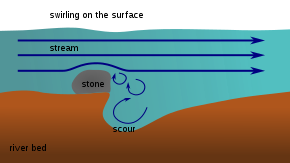Hydrodynamic scour
Hydrodynamic scour is the removal of sediment such as silt, sand and gravel from around the base of obstructions to the flow in the sea, rivers and canals. Scour, caused by swiftly moving water, can scoop out scour holes, compromising the integrity of a structure. It is an interaction between the hydrodynamics and the geotechnical properties of the substrate. It is a notable cause of bridge failure and a problem with most marine structures supported by the seabed in areas of significant tidal and ocean current. It can also affect biological communities and heritage assets.[1][2]
Mechanism

Any obstruction within flowing water will produce changes in velocity within the water column. The flow changes that occur in the vicinity of the substrate may cause differential movement in the bed materials near the obstruction. The magnitude of these changes varies with stream velocity, feature shape and substrate character. Generally the stream bed is deepened at the upstream end of the obstruction, and the material removed from the substrate is usually deposited in the sheltered areas behind or adjacent to the obstruction where the local velocity is sufficiently reduced. In conditions of high stream velocities, mobile bed materials, and poorly streamlined structures scour depths can be quite deep.[3]
See also
References
- Melling, Greg; Dix, Justin; Turnock, Stephen. "Research project: Hydrodynamic and Geotechnical Controls of Scour Around Offshore Monopiles". Ocean and Earth Science, National Oceanography Centre Southampton. University of Southampton. Retrieved 6 July 2016.
- Melling, Gregor J. (2015). "Hydrodynamic and geotechnical controls of scour around offshore monopiles". Doctoral Thesis. University of Southampton, Ocean and Earth Science. p. 250pp. Retrieved 6 July 2016.
- Staff (January 2009). "Hydrodynamics briefing note No 3 Local Scour – Draft Rev B" (PDF). The Mersey Gateway. Retrieved 6 July 2016.